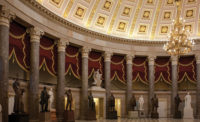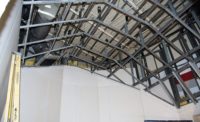Last summer, while researching an acoustic levitation device supposedly invented in the early-1600s, my youngest son and I were invited for a personal tour of Riverbank Acoustical Laboratories in Geneva, Ill. Six years before the existence of RAL, in 1912, it was here on Colonel Fabyan’s Riverbank Estate that this same acoustic levitation device was constructed from instructions discovered in an old book. After several failed attempts to make the device fly, Fabyan finally asked acoustics expert and Harvard Professor, Wallace Clement Sabine to examine the situation. Professor Sabine quickly debunked the acoustic levitation device as a hoax, but convinced the grateful Colonel to construct on the estate the world’s first scientific acoustics testing laboratory; Riverbank Acoustical Laboratories. Presently, at 102 years old, RAL continues to be the leader in certified acoustics testing.
Establishment of the Riverbank Estate
Colonel George Fabyan is, without doubt, one of Chicago’s most colorful historical characters. An outcast in his own family, the Colonel nevertheless inherited most of his fortune from his father. George’s father was head of the Bliss Fabyan Corporation which at that time was the world’s largest dry goods commissioning agent. George was put in charge of the company’s second largest office in Chicago, and he and his wife Nelle established their home in 1905 on a 300-acre farm in nearby Geneva, Illinois, on the banks of Fox River (hence the place name Riverbank Estate). From 1905 until his death in 1936, Colonel Fabyan developed Riverbank Estate into a colony of artists and scientists (much like Edison’s Menlo Park). The Colonel hand-selected each of the hundreds of resident artists and scientists to advance his own pet theories, and he made certain the name “George Fabyan” always got primary credit for their research findings.
Frank Lloyd Wright and Taro Otsuka
After 1939, much of Riverbank Estate was divided up and sold off; however, you can still visit many of its unique buildings. The Fabyan home, redesigned by Frank Lloyd Wright along with its Japanese Garden, designed by Taro Otsuka, were purchased by the county Forest Preserve and continue to be popular tourist spots. On the opposite side of Lincoln Highway, the Riverbank Laboratory buildings which still exist include the “Lodge” where many of the resident scientists lived, the Wallace Clement Sabine Laboratory of Acoustics, and the unusual looking, multi-tiered Engineering building.
Obsession with Baconian Theory
One of the more tenacious conspiracy theories of the late nineteenth century was the assertion that Francis Bacon (known for, among other things, inventing a method of hiding secret messages in letters) had ghost written all of Shakespeare’s works for him. For the next fifty years, this bizarre idea sparked a frantic search by Bacon Societies throughout the United States for messages they imagined Bacon should have hidden within Shakespeare’s First Folio and other books of the period. Colonel Fabyan and his money got caught up in this frenzy when he was approached by Dr. Orville Owen, who claimed to have deciphered a treasure hunt clue from Bacon which would require Fabyan to fund a small expedition to England (lead by Owen and close friends) to search for the next clue. Colonel Fabyan bankrolled Dr. Owen’s party from 1910 to 1912 before Owen finally sent word that he had found a stone inscription from Bacon along with an illustration of an airship which apparently used sound to create lifting force.
Establishment of Riverbank Department of Ciphers
While Owen’s expedition was allowed to continue its search, Colonel Fabyan was introduced to Owen’s former stenographer, Elizabeth Wells Gallup and her sister, both whom he hired with the task of creating what was later named the Department of Ciphers at Riverbank to find more of Francis Bacon’s hidden messages.
Gallup proceeded to shake loose hidden stories of Elizabethan Royal intrigue and scandal from her readings, which she shared at the group’s dinner table each evening. Later that year, Elizabeth Gallup produced Bacon’s description of the acoustic levitation device. Excited by the “discoveries,” Colonel Fabyan hired Riverbank’s chief engineer, Bert Eisenhour, to build and test the acoustic levitation device.
Ironically, although no one else on her staff was ever able to corroborate any of Gallup’s decoding, Riverbank’s Department of Ciphers did attract and develop hundreds of very talented codebreakers. After the World War I, it was revealed the group at Riverbank had decoded most of the enemy messages intercepted by all US military branches as well as those from Scotland Yard.
Professor Sabine
When the acoustic levitation device failed to fly as advertised, Colonel Fabyan turned to his brother, a trustee of Harvard University, to find an expert in acoustics. His brother introduced him to Harvard Professor, Wallace Clement Sabine, who had recently developed reliable acoustic design equations (still in use today) based on his 16 years of acoustics testing of building materials in a Harvard basement. Sabine’s test equipment consisted of an organ pipe as a source of sound, his sense of hearing and a chronograph to measure the time it took for sound to fade within the room. Since sound absorbing panels were not yet thought of, Sabine’s very first measurements of sound absorption were of hundreds of seat cushions, borrowed from the nearby, 1,500 seat Sanders Theatre.
Sabine visited Riverbank in 1913 and quickly convinced Fabyan his acoustic levitation device had no supporting science behind it. As a result, the Colonel sent his finance officer to England to stop Dr. Owen’s expedition and to audit Fabyan’s losses on the treasure hunt hoax. By 1915, impressed with Sabine’s experiments and wanting to return a favor, Colonel Fabyan offered to build an acoustic testing laboratory for the Professor on his quiet country estate. Sabine agreed and delivered his design blueprints in 1916. Construction of the lab was completed in 1918. Since then, the lab has served as the center of much of the scientific study and certification of new acoustic concepts and building products.
Our Visit to Where it all Began
Although the labs have changed ownership a couple of times since it was built, we were continually impressed on our visit by how much of it is original to Professor Sabine’s design.
We first took a stroll through the grounds and quickly ran into construction crews finishing new condominiums immediately behind the lab buildings.
Although the surrounding neighborhood has slowly overtaken the original 300-acre farm, the architecture and landscaping of the remaining laboratory campus still feels collegiate.
Professor Sabine did not live to see his lab’s completion, but the acoustic lab was dedicated in his name. Colonel Fabyan hired Professor Sabine’s cousin and fellow Harvard physicist, Dr. Paul Sabine to operate the lab, which he did from 1919 until 1947. A dedication photo shows Colonel Fabyan and Dr. Sabine at the lab’s entrance, so we naturally were compelled to strike the same thoughtful pose before entering.
We met our hosts, Laboratory Manager, Eric Wolfram and Test Engineer/Acoustician, Malcolm Kelly working in their offices on the second floor. The interior architecture of the historic building has been maintained in its near original but fully operational condition. A large plaster relief above the fireplace mantle in one office was created in 1914 on the Riverbank Estate by “Princess” Helen Morton (heiress to the Morton Salt family fortune) during her court ordered exile here. Architectural details throughout the building tell more interesting stories.
On the third floor we roamed through the library. One of the rooms here serves as a museum of historic acoustic lab equipment retired from use: electric tuning forks, spectrum analyzers, sound level meters, an instrumented mannequin head, calibrated microphones, scales and several display cases of equipment of obscure origin. One table displays a panoramic class photo of the first soldiers to graduate from Riverbank’s Cipher program along with instructions on how to decipher a secret message those students hid within the photo.
Sitting on top of one of the library’s display cases is the sole surviving seat cushion from Sanders Theatre in Cambridge; the test subject of Professor Sabine’s ground-breaking, 1895 acoustic experiments.
We next moved to the basement of the facility and its acoustics test chambers, warehousing space for items awaiting testing, and test article preparation areas.
Professor Sabine’s original test chamber, Test Room #0, is a highly reverberant sound chamber with a volume of 292 cubic meters. Reverberation chambers are used to measure sound absorption of newly developed products, as well as to measure the sound power generated by small power tools and equipment. Sabine designed this chamber as a room encased within another room with a 2-foot air gap between them. The concrete walls of both the test chamber and those of the enclosing outer room are 18 inches thick, and the poured ceilings are an impressive 27 inches thick. Since speed of sound varies with air temperature and humidity, all testing chambers are climate controlled within 1°C and 2 percent relative humidity. Fixed diffuser panels attached to the walls and rotating diffuser panels in the center of the chamber operate to prevent standing waves and to randomize the sound field.
Test Rooms #1 through #4 are later additions to the lab, occupying an extension to the building. These connected test chambers are used to test the noise and impact isolation provided by new wall and ceiling/floor assembly designs. Wall assemblies are given certified STC ratings and ceiling/floor assemblies are given certified STC and IIC ratings. Each chamber has 20-inch-thick walls constructed of two separated courses of high-density solid concrete blocks. Assemblies to be tested are prebuilt within large, colorful metal frames. Each metal frame is precisely dimensioned to plug the large open passages connecting adjacent chambers. The framed test assembly is positioned to block the passage, the drop in noise transfer between chambers is measured, and the framed test assembly is moved out in preparation for the next test item. It is a busy place.
Since noise levels within the test chambers can be loud, and since accurate measurements can be difficult to achieve when humans are in the chamber creating and absorbing their own sounds, the test chambers at Riverbank Acoustical Laboratories are operated from the first floor Control room; the last stop on our tour. Here again, I was impressed that RAL has been intentional in its efforts to maintain a historically correct look while providing state of the art testing facilities. Modern control equipment is mounted within equipment frames originally designed for vacuum tube sets. The sunlight pouring through Colonel Fabyan’s collection of ship portholes in the control room wall completes the art deco decor.
We thank Eric Wolfram, Malcolm Kelly, the Riverbank Acoustical Laboratory staff, and Alion Science and Technology Corporation for allowing us to visit with you. I can’t imagine a more inspiring place to work than the place where it all began.














Report Abusive Comment